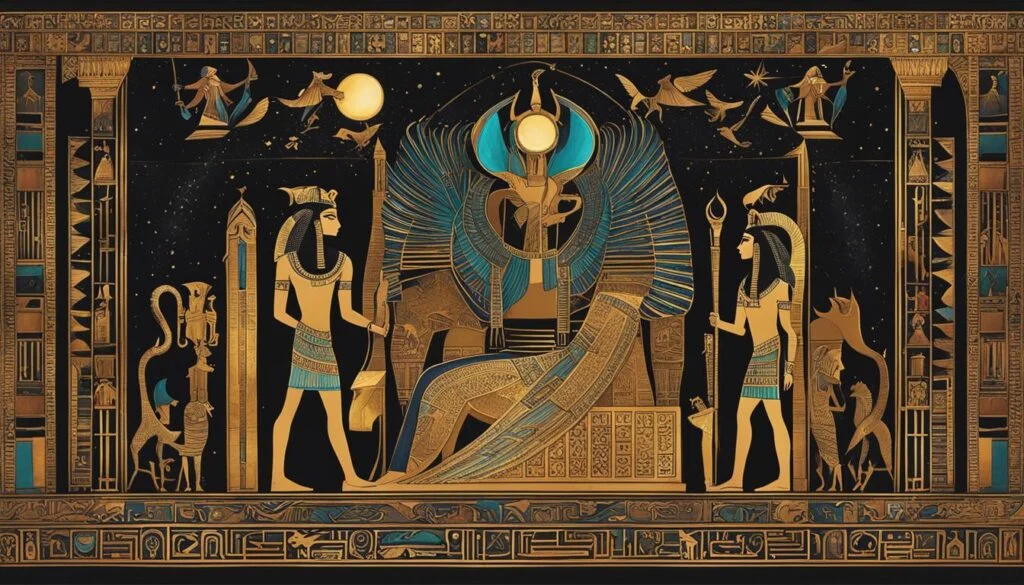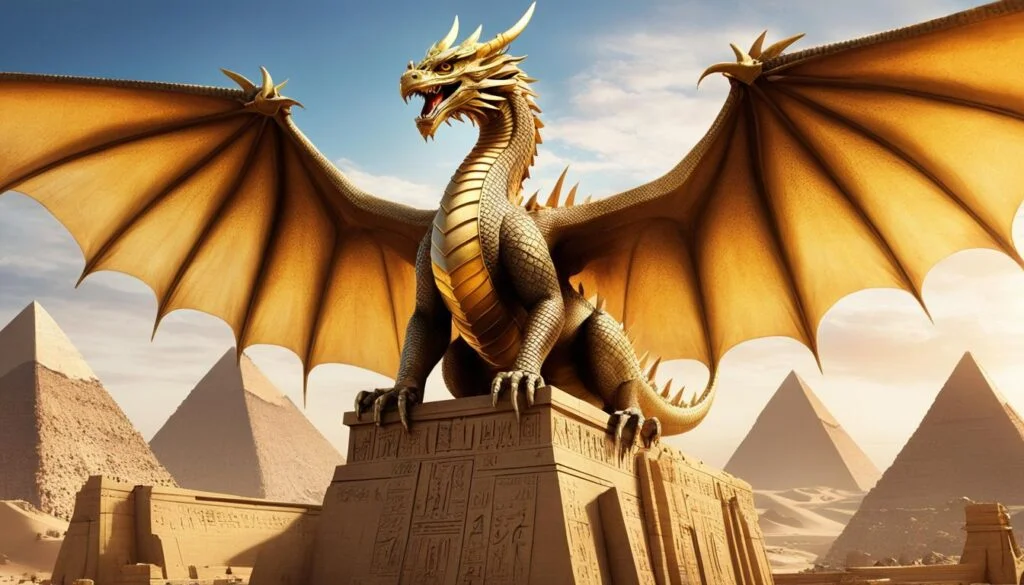Welcome to our exploration of the fascinating world of cats in ancient Egypt! In Egyptian mythology, cats held a significant role as divine creatures embodying the qualities of protection and divinity. Let’s delve into the significance of these mythological felines and their place in ancient Egyptian religion.
Key Takeaways:
- Cats in Egyptian mythology were not worshiped as deities but were considered representations of divine aspects of the gods.
- They provided companionship to the ancient Egyptians and helped control pests like snakes and scorpions.
- Cats played a vital role in the afterlife, depicted in paintings in tombs and often mummified and buried alongside humans.
- One of the most prominent feline figures in Egyptian mythology is the cat goddess Bastet, associated with protection and fertility.
- Cats were highly regarded in ancient Egyptian society, especially among the royal class, who adorned them and followed their practices.
Cats as Companions and Protectors in Ancient Egypt
Cats played a unique role in ancient Egyptian society, serving as both companions and protectors. Their presence in ancient Egyptian art and their significance in the afterlife highlight their importance in Egyptian culture.
In ancient Egyptian society, cats were seen as mutually beneficial companions. They were depicted in paintings on tomb walls, often shown laying or sitting below chairs, chasing birds, and playing. These artistic representations captured the close bond between humans and cats, illustrating the role of cats as household pets.
Cats in ancient Egyptian society were valued for their ability to chase away dangerous animals like snakes. Their keen senses and hunting skills made them essential in protecting homes and crops from pests. Egyptians recognized their innate ability to keep the environment safe and sought their presence in their daily lives.
In addition to their role as companions and protectors in the mortal realm, cats were believed to provide companionship and protection even in the afterlife. Tomb scenes depicted cats accompanying individuals in their daily activities, suggesting that their presence was desired even in eternity. The ancient Egyptians believed that the bond between humans and their feline companions extended beyond the earthly realm.
These depictions of cats in ancient Egyptian art and the inclusion of cats in tomb scenes reveal the profound connection between humans and cats in ancient Egyptian society. Cats were not only valued for their practical contributions but also cherished as beloved companions that held a special place in the hearts of the ancient Egyptians.
Feline Symbolism in Egyptian Culture
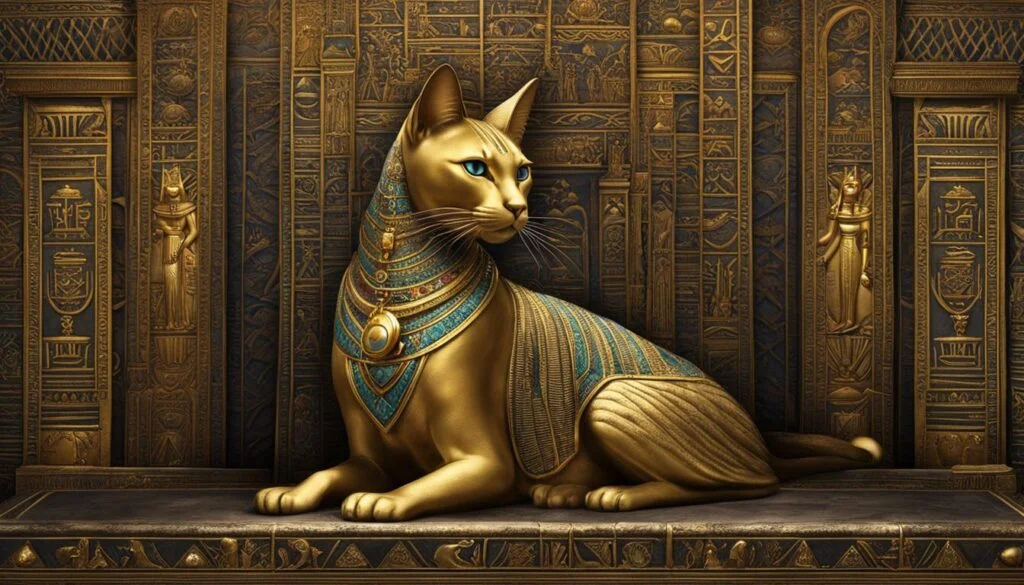
The ancient Egyptians had a deep reverence for cats and attributed various symbolic qualities to these feline creatures. One prominent figure in Egyptian mythology associated with cats is the cat goddess Bastet. Originally depicted as a fierce lioness, Bastet later took on the form of a domestic cat or a feline-headed woman.
Cats in ancient Egypt were believed to embody qualities such as grace, aggression, fecundity, and protection. They were seen as symbols of fertility and were often depicted sitting under women’s chairs, emphasizing their association with femininity and maternity. Additionally, cats were believed to offer protection against enemies and illnesses, with the goddess Sekhmet representing their fierce and protective aspect.
The Egyptian cat goddess Bastet played a significant role in the feline symbolism of Egyptian culture. She was revered as a protector and nurturer, embodying the qualities associated with cats in ancient Egypt. Images of seated cats, cat-headed goddesses, or cats with kittens often accompanied dedicatory inscriptions that expressed desires for health, children, life, and protection.
Symbolism of Cats
- Grace: Cats were seen as graceful creatures, possessing an elegant and poised demeanor.
- Fecundity: Cats symbolized fertility and reproduction, reflecting their association with the goddess Bastet.
- Aggression: Cats were also recognized for their fierce nature, embodying both protective and predatory instincts.
- Protection: Cats were revered as guardians, offering defense against enemies and diseases.
Cats held a significant place in Egyptian culture, with their symbolism permeating various aspects of everyday life, religious beliefs, and artistic representations.
Egyptian Cat Worship and Royal Influence
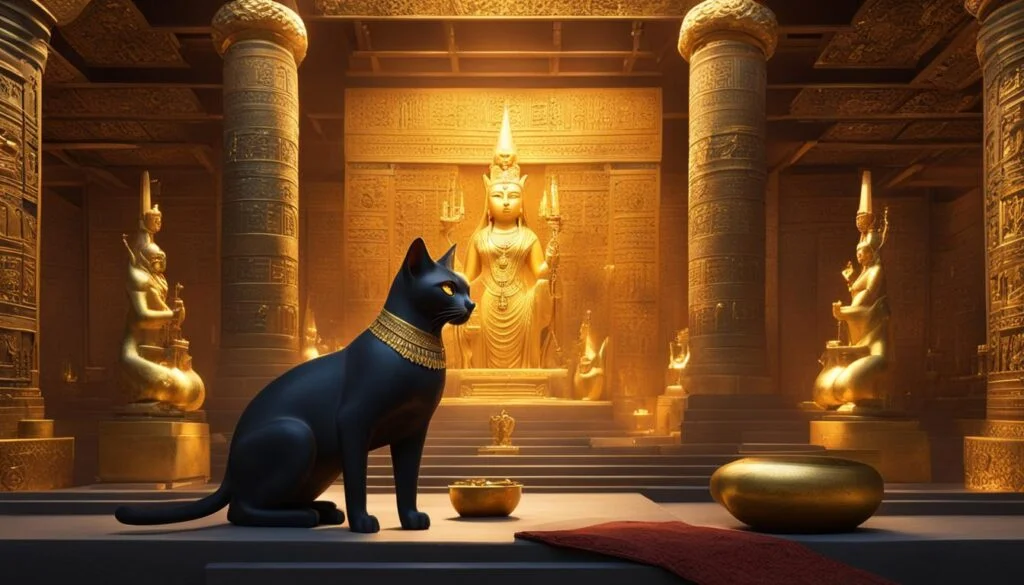
The ancient Egyptians held cats in high regard due to the practices and preferences of their gods and the influence of the pharaohs. Cats were not worshiped themselves but were seen as vessels for the gods to inhabit. Members of the royal class dressed their cats in gold and allowed them to eat from their plates. The ruling class set trends that were followed by the general population, including owning and adorning cats.
Cat Mummification and Divine Presence
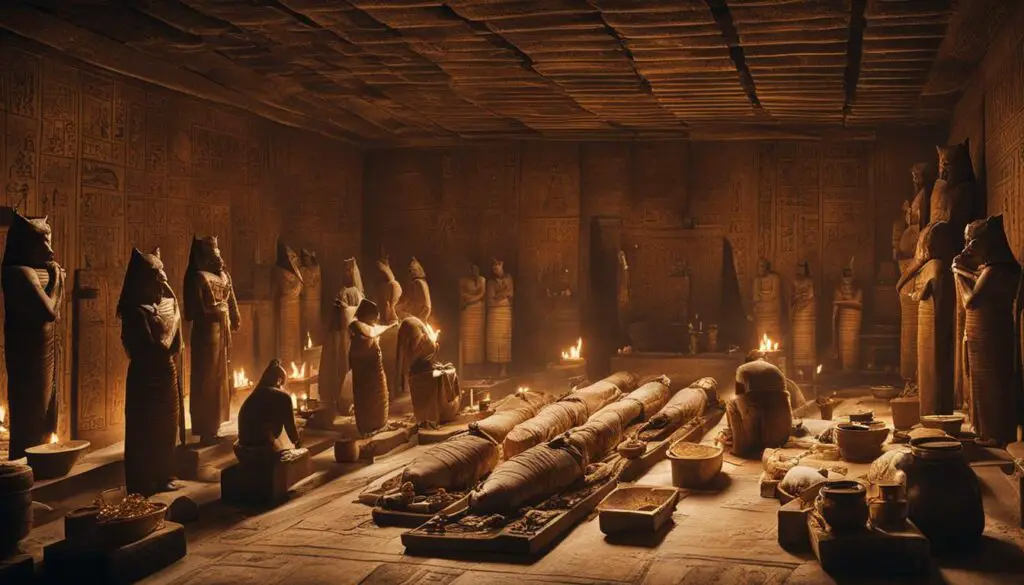
In ancient Egypt, cat mummification was a common and revered practice. While cats themselves were not considered gods, they were seen as vessels that the gods chose to inhabit, making them a divine presence in Egyptian culture. Mummified cats held a special significance and were considered offerings to the gods and used as funerary goods.
The killing of cats was strictly forbidden, with the exception of mummification. This widespread practice contributed to the ubiquity of mummified cats in ancient Egyptian art, fashion, and home ornamentation. These mummified feline figures served as reminders of the gods’ power and the reverence with which cats were held in Egyptian society.
The Divine Presence of Cats in Ancient Egypt
- Cat mummification was a common practice in ancient Egypt.
- Cats were seen as vessels for the gods, not worshiped as gods themselves.
- Mummified cats were believed to be offerings to the gods and used as funerary goods.
- The killing of cats was forbidden, except for the purpose of mummification.
- The widespread mummification of cats contributed to their presence in ancient Egyptian art, fashion, and home ornamentation.
The Significance of Bastet, the Cat Goddess
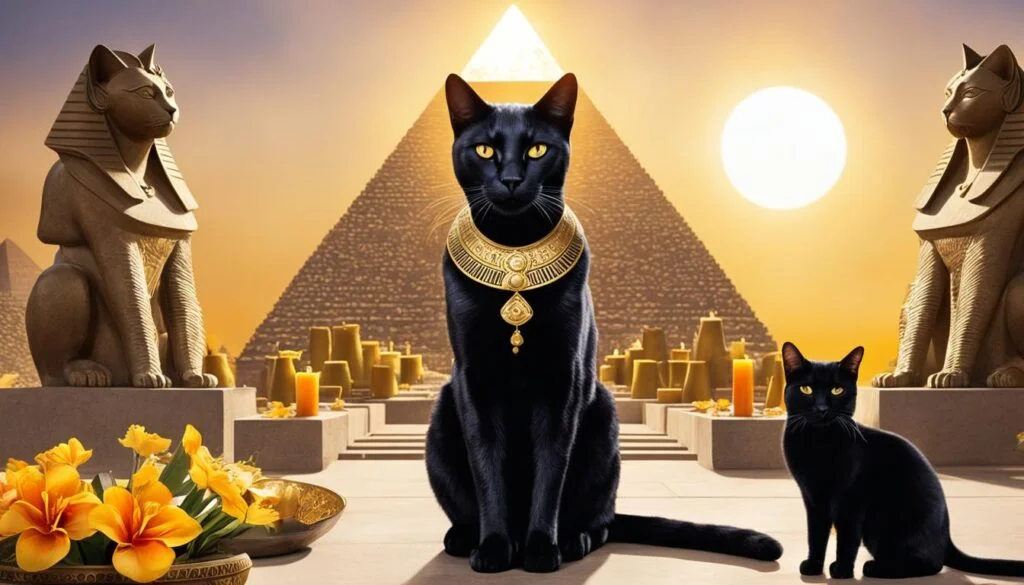
Bastet, the cat goddess, held great significance in the ancient Egyptian culture. She was revered for her nurturing and protective qualities, making her an important figure among the Ancient Egyptian goddesses. Bastet was often depicted in various forms, including images of seated cats, cat-headed goddesses, or cats with kittens. These depictions highlighted her association with motherhood and protection.
Many dedicatory inscriptions addressed to Bastet expressed wishes for health, children, life, and protection. People believed that by invoking her name and praying to her, they would receive her nurturing and caring qualities in their own lives. Bastet represented a combination of attributes, embodying both nurturing and violent qualities. However, her role as a protector and nurturer was emphasized in the cultural consciousness.
To further demonstrate the significance of Bastet, her images and statues were often placed in homes, temples, and other sacred spaces. These representations served as reminders of her divine presence and the protective aura she brought. People sought Bastet’s favor and invoked her power to safeguard their homes, families, and communities from harm.
The Symbolic Role of Bastet
Bastet’s association with cats and feline symbolism also held symbolic meaning in ancient Egyptian culture. Cats were seen as agile, independent, and intelligent creatures—traits commonly associated with Bastet. As a goddess of protection, Bastet was believed to ward off evil and protect against illness and misfortune.
In addition, Bastet’s nurturing qualities were emphasized through her association with cats and kittens. Cats were known for their nurturing behavior towards their young, mirroring Bastet’s caring nature. Consequently, depictions of Bastet often included cats with kittens, reinforcing her role as a protector and nurturer.
Bastet in Egyptian Mythology
Bastet’s significance extended beyond individual devotion and household protection. She played a vital role in the grander narrative of Egyptian mythology.
- Bastet was considered an ally of Ra, the sun god.
- She was believed to accompany the sun god Ra on his daily journey across the sky, protecting him from his enemies.
- As a feline deity, she also shared an association with the goddess Sekhmet, who embodied a more aggressive aspect of feline behavior.
- These connections reinforced Bastet’s position as a powerful and multifaceted goddess within the Ancient Egyptian pantheon.
Overall, Bastet’s significance as the cat goddess in ancient Egypt cannot be understated. She represented the nurturing and protective qualities that cats were admired for, making her highly revered among the Ancient Egyptian goddesses. Through her depictions, people sought her blessings and invoked her power to nurture and safeguard their lives.
An Unusual Cat Figurine and Its Function
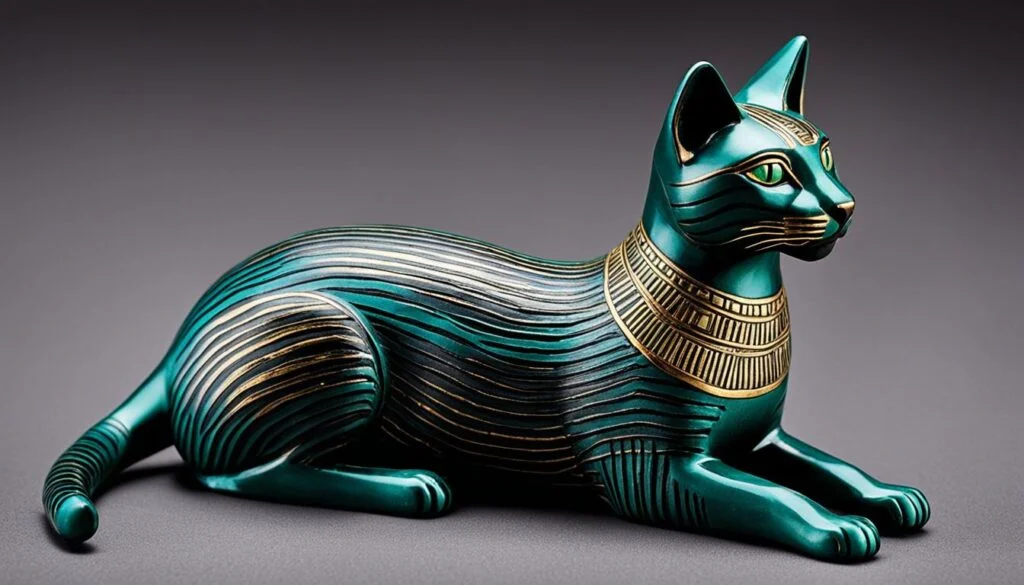
An unusual cat figurine was discovered in the Brooklyn Museum. It depicted a goddess with a feline head and leonine ears, sitting on a floral base. The figurine contained a small cat mummy in its hollow interior and was likely used as a special cat mummy container or a votive offering to the goddess Bastet. The figurine’s unique features and its connection to cat mummification highlight the intricate beliefs and practices surrounding cats in ancient Egypt.
Various Depictions of Cats in Ancient Egyptian Art
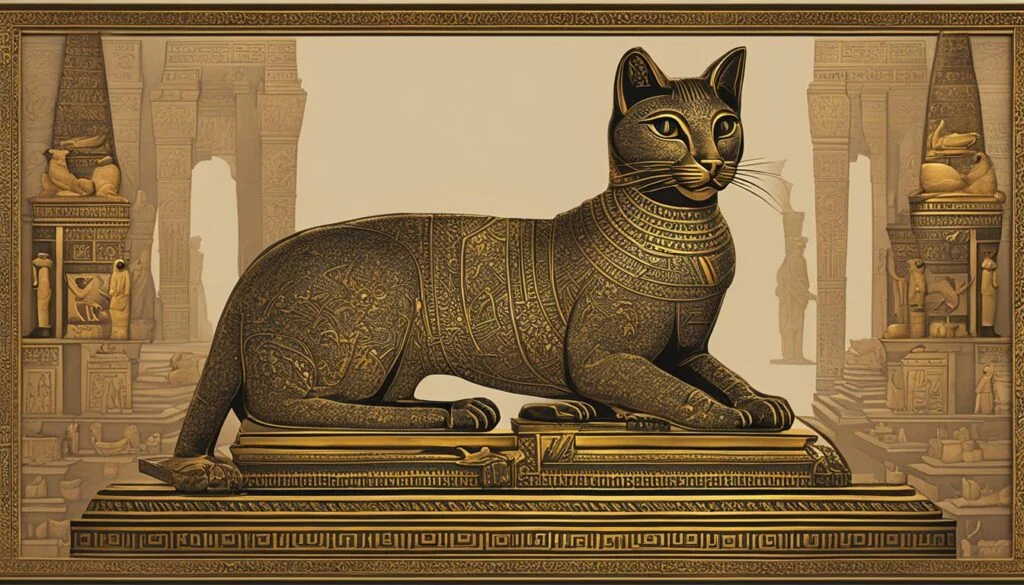
Ancient Egyptian art celebrated cats in various forms, including stunning statues and intricate paintings. These artistic representations not only captured the physical likeness of cats but also imbued them with symbolic elements that held deeper meaning in Egyptian culture.
Cat Statues: Cat statues were a popular form of representation in ancient Egyptian art. These statues ranged in size from small figurines to life-sized sculptures. They were meticulously crafted to capture the grace and elegance of cats, showcasing their sleek bodies and distinctive features. Cat statues served various purposes, including as decorative pieces in homes, votive offerings in temples, and even as containers for mummified cats.
Symbolic Elements: Cats in ancient Egyptian art were often depicted with symbolic elements that added layers of meaning to their representation. One common symbolic element was the scarab, a dung beetle associated with the morning sun and the cycle of life and rebirth. The presence of a scarab in cat depictions emphasized the divine nature and eternal life associated with these feline creatures.
Earrings were another symbolic element frequently shown adorning cat heads in ancient Egyptian art. These earrings followed the ornate Roman Egyptian style and added a touch of opulence and beauty to the cat representations. The presence of earrings highlighted the significance of cats in terms of their adornment and aesthetic appeal.
The artistic depictions of cats in ancient Egypt were not just static representations but carried a profound cultural significance. They showcased the Egyptians’ reverence for cats and their belief in their divine qualities. These representations served as reminders of the cats’ role as protectors, companions, and even vessels for the gods.
Conclusion
Cats held a prominent and revered position in ancient Egyptian mythology. These divine felines were not only admired for their hunting prowess but were also regarded as symbols of protection, divinity, and fertility. Cats served as loyal companions, providing comfort and companionship to the ancient Egyptians, while simultaneously safeguarding their homes from dangerous pests.
The influence of the royal class further elevated the status of cats in ancient Egyptian society. Cats were adorned with gold and received preferential treatment, often dining from their owners’ plates. While not worshiped directly, cats were seen as vessels through which the gods could manifest their divine presence.
Mummification further immortalized the significance of cats in ancient Egypt. Mummified cats were offered to the gods, with their preserved bodies serving as reminders of the gods’ power and protection. The intricate depictions of cats in ancient Egyptian art also reinforced their presence in everyday life and the afterlife. These artistic representations showcased the cat’s symbolic elements, emphasizing their association with the sun, fertility, and protection.
The deep reverence and complex symbolism surrounding cats in ancient Egypt highlight their profound impact on the culture and beliefs of the time. Through their association with divinity, companionship, and protection, cats played an integral role in ancient Egyptian mythology, leaving an enduring legacy that resonates to this day.
FAQ
What role did cats play in ancient Egyptian society?
Cats in ancient Egypt served as companions, protectors, and pest controllers. They were highly revered and depicted in paintings on tomb walls, showing them sitting under chairs, chasing birds, and playing.
Were cats worshiped as deities in ancient Egypt?
Cats were not worshiped as deities themselves, but they were seen as representations of divine aspects of the gods. They were associated with various qualities like grace, fecundity, aggression, and protection.
Who is the cat goddess in Egyptian mythology?
The cat goddess in Egyptian mythology is Bastet. Initially depicted as a fierce lioness, she later represented as a domestic cat or feline-headed woman. She was associated with nurturing and protective qualities.
Why were cats mummified in ancient Egypt?
Cats were mummified in ancient Egypt as offerings to the gods and as funerary goods. They were believed to provide companionship and protection, even in the afterlife. The killing of cats was forbidden, except for mummification.
Did cats have a special significance in the afterlife?
Yes, cats were believed to accompany individuals in their daily activities in the afterlife. Paintings in tombs depicted cats as companions and protectors even in the afterlife, emphasizing their significance.



